Final report for FS22-342
Project Information
Conventional methods for establishing new silvopasture may include unnecessary material and labor costs that constrain the practice's cost-effectiveness, generate unnecessary waste, and do not minimize tree mortality. Material costs and off-site inputs that could potentially be reduced are weed mats, mulch, compost, herbicide, and tree tubes. Labor costs that could potentially be reduced include mowing, weeding, watering, mulching, installation and removal of tree mats, and installation and removal of tubes. In place of these relatively high-input methods, we hypothesized that lower-input methods could be used that are less costly, generate less waste, and are ultimately more effective for growing healthy trees. This project attempted (1) to replace compost, mulch, weed mats, herbicide, and ongoing watering with “living mulch,” (i.e. cover crops) that would provide equivalent or better weed suppression, water retention, and tree nutrition. It also attempted (2) to replace tree tubes, stakes, and unnecessary exclusion fencing with "plant deterrents" (cut brush and/or live low-palatability species), minimal adjustable polywire fencing, and carefully executed grazing management. Our theory was that by using materials found on-site and techniques that are already a part of the grazier's routines, we can reduce costs, reduce waste, and decrease tree mortality. Initial results indicate that (1) cover crops caused more harm than good, due to imprecise seeding rates resulting in allelopathy (2) tree mortality rate was driven primarily by weather and trees' success at transitioning from the nursery to the field, (3) although tree tubes do initially add some labor costs, over the long-run, they are highly effective at growing trees reliably straighter and taller (though they do not overcome major mortality factors), with considerably less labor costs. Relative success of different plant deterrents is pending an analysis of 2025 grazing sessions.
Primary Objective
After reviewing as many cost analyses of new silvopasture establishment that we could find, we found that the establishment costs of new silvopasture for shade was prohibitively expensive, at scale, for our farm. Although costs per tree were usually given as roughly $50 (+/-$20) often these costs did not take mortality rates into consideration, and the labor costs reported appeared to have left out significant parts of any planting process (likely due to the fact that the laborers were initiating self-reporting rather than taken by collecting hours from payroll). Given these considerations, it appears that at the time of the project proposal, producer establishment (as opposed to specialized tree-planting companies' methods) was averaging costs between $50-$100 or more per living tree, after roughly two years. Sometimes costs per living tree were significantly higher, as well, since in many projects mortality was over 50% or more. This resulted in an overall low cost-effectiveness that is surely a hindrance to the wider adoption of silvopasture by cattle producers.
We hypothesized that the costs per living tree could be significantly reduced, and tree survival improved, by using alternative methods that replace conventional “landscaping” materials and maintenance activities with the “pasture-focused” materials and activities regularly employed by livestock producers in the Southeast. Specifically, we proposed to replace compost, mulch, ongoing watering, and mowing with “living mulch,” (i.e. cover crops), deterrent plants (cut brush and/or live low-palatability species), adjustable polywire fencing, and carefully executed grazing management.
Background
Living Mulch
Many efforts to establish trees utilize mulch and/or ongoing mowing or spraying, to suppress weed competition. We tested the viability of using cover crops as a “living mulch” alternative. Cover crops have been shown to reduce weed competition, conserve moisture, and benefit soil health (1). We hypothesized that cover crops are an effective and affordable solution to weed suppression. Furthermore, by supporting tree health and drought tolerance, living mulch may reduce tree mortality from non-browsing causes.
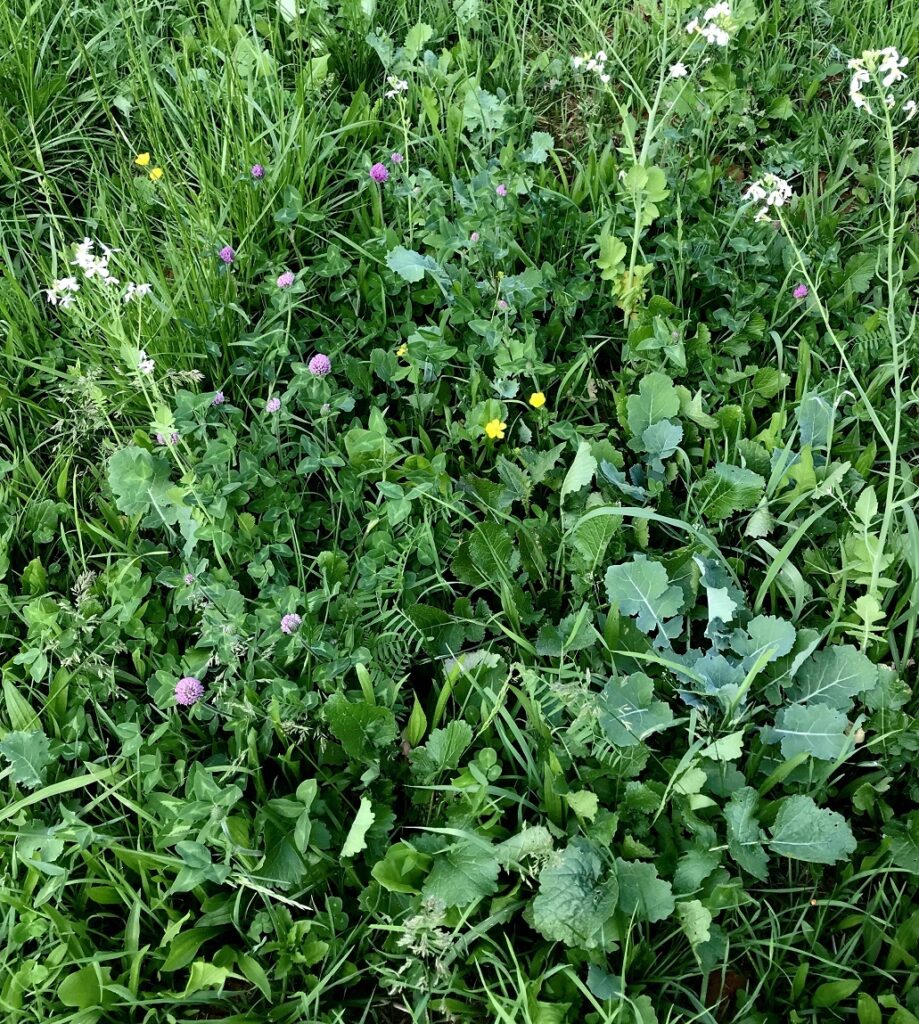
Plant Browsing Deterrents: “Brambles”
In recent years, conservationists in the UK have concluded that using “brambles” (Rubus spp.) to naturally regenerate forests is a more cost-effective afforestation strategy than traditional tree-planting (2). These “brambles” are early succession natives with thorns that deter herbivory. They provide saplings protection, only to be shaded out later as those saplings mature. A similar concept was tested in a silvopasture application in SARE # FNE19-939, “Tree Regeneration and Establishment Strategies in Silvopasture and Sugarbush Systems.” However, this case study took place in a woodland context, and trees were planted into existing invasive species (Japanese barberry, Multiflora Rose).


We proposed to test this concept out with native species, in new silvopasture establishment, into existing pasture. We used various native and exotic species of “plant deterrent” ("PD") that were already found on the farm. Some of the PDs were cut brush, and others were live plants. These were planted/arranged around the target silvopasture tree species and initially protected by polywire fencing. We compared the “PD” method to conventional methods used elsewhere: plastic tubes and exclusion fencing (3, 4). We hypothesized that PDs may be as effective as other deterrent methods, and/or may be less expensive to obtain and install on a large scale. They may also allow one to avoid the well-documented performance pitfalls and environmental downsides documented by others (5).
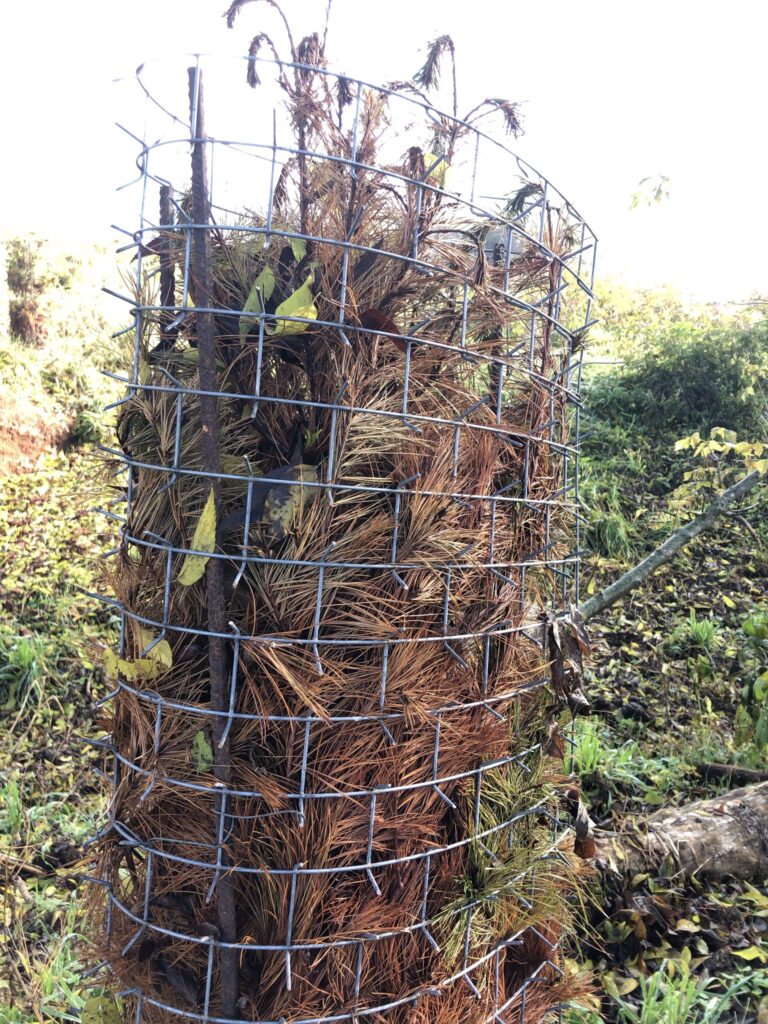
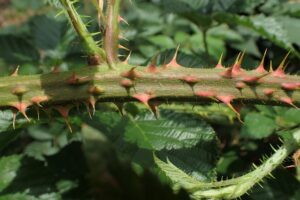
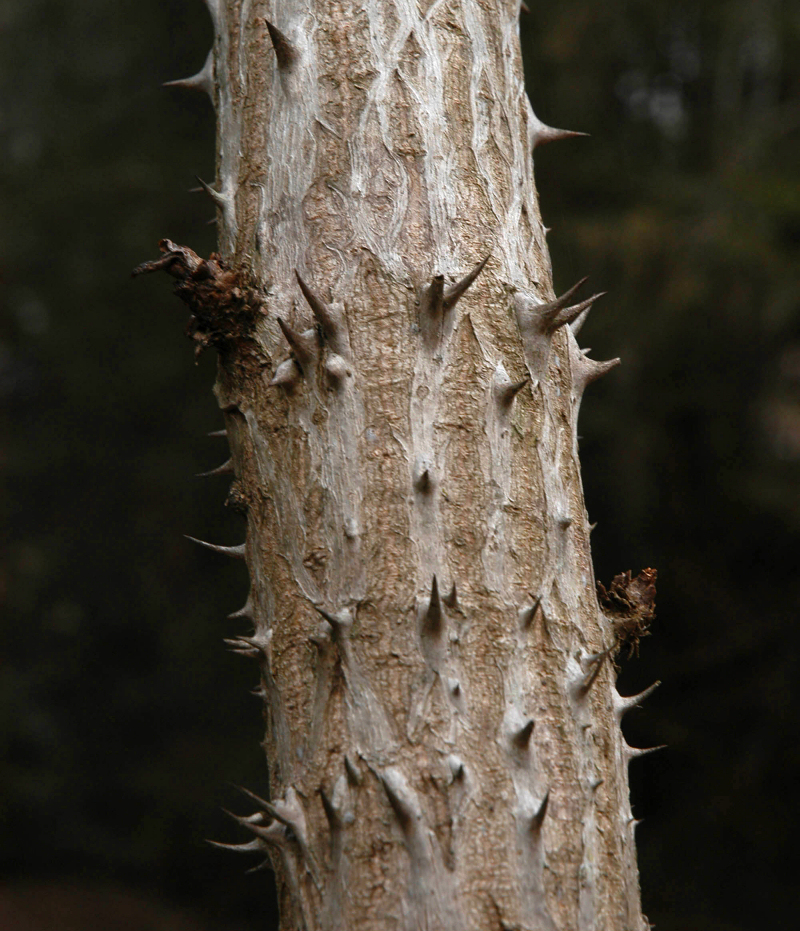
(1) https://www.nrcs.usda.gov/wps/portal/nrcs/detail/ny/technical/?cid=nrcs144p2_027252
(2) https://www.bbc.com/future/article/20210524-the-reason-wild-forests-beat-plantations
(3) SARE Project #ONC16-017, Savanna Institute, 2019.
(4) SARE Project # LNE20-405R, Chesapeake Bay Foundation, ongoing.
(5) https://www.sciencedirect.com/science/article/abs/pii/S0048969721033106
Research
Experimental Design
Our research design entails 8 treatments:
- Living Low-palatability Herbaceous Plant Deterrent (native) - Wingstem (Verbesina alternifolia)
- Living Low-palatability Herbaceous Plant Deterrent (native & exotic)- Mixed Mints (Lamiaceae spp.)
- Living Low-palatability Woody Plant Deterrent (native) - Elderberry (Sambucus canadensis,)
- Living Thorned Woody Plant Deterrent (native) - Blackberry (Rubus allegheniensis)
- Large-diameter Cut Brush Plant Deterrent (native & exotic) - Honey Locust (Gleditsia triacanthos), Bradford Pear (Pyrus calleryana), & Russian Olive (Elaeagnus angustifolia)
- Small-diameter Cut Brush Plant Deterrent - Blackberry & Multiflora Rose (native & exotic)
- Tree Tubes (Initially 5' Tree Pro Slit Tubes with Bamboo stakes, then upgraded to 6' Plantra Sunflex System)
- Control - No deterrent
All treatments were protected throughout establishment with two strands of polywire set at roughly 22" and 34."
These 8 treatments were replicated four times. Although the original proposal replicated half of the treatments in a pastured poultry scenario, and half in a cattle scenario, farm operations and staffing changed during the project timeline such that poultry was not an option. Therefore, the two variables represented by four replications is (1) high-quality versus low-quality soil, and (2) high-density versus low-density grazing. This research design resulted in 32 test plots (8 treatments x 2 soils x 2 densities).
|
|
Poor Soil (Recently Disturbed, Poor Structure/ Infiltration, Lower OM) |
Good Soil (Undisturbed, Excellent Structure/ Infiltration, Higher OM) |
|
High Density (~100,000lbs/ac) |
1 row of 8 deterrent treatments |
1 row of 8 deterrent treatments |
|
Low Density (~10,000lbs/ac) |
1 row of 8 deterrent treatments |
1 row of 8 deterrent treatments |
Each of the 32 test plots was planted with 10 target silvopasture trees that represented high- and low-palatability species, as well as deciduous versus coniferous. Each plot included 1 Persimmon, 1 Loblolly Pine, 4 Lombardy Poplar, and 4 Red Mulberry. In total there were 320 target silvopasture trees planted.
Site Preparation
All 4 replication rows were located in existing treeless pasture composed primarily of hard fescue, annual ryegrass, and johnsongrass. Prior to planting, rows were disced in 5' strips and subsoiled to 6" in the center of the row, and a cover crop mixture was broadcast over the area, then worked in with a drag on an ATV.
During the cover crop establishment and beyond, a double-strand energized polywire fence was installed around all rows to exclude cattle. The prepared planting strip and the area excluded from cattle were about 2.5' out from the center of the row, making the entire row about 5' wide.
Planting
Living PDs were planted first, and the target silvopasture species were planted the following season. Trees were planted along the row on roughly 1' centers, mimicking close spacing as used in "fodder banks." All trees were planted directly into the soilsoiled line, through the expired cover crop. Trees were planted with a dibble or a shovel, and watered in.
Grazing
Cattle were allowed to graze around all rows during the establishment period (4/1/22 - 4/1/25) of the PDs and target silvopasture trees, which were protected by two strands of polywire set at roughly 22" and 34." Minimal browsing damage occurred throughout this period. No mortalities were caused by browsing during this period. After the establishment period (after 4/1/25) we plan to graze half of the rows at a low-density (roughly 10k lbs/ac) and half of the rows at a high-density (roughly 100k lbs/ac), without any exclusion fencing.
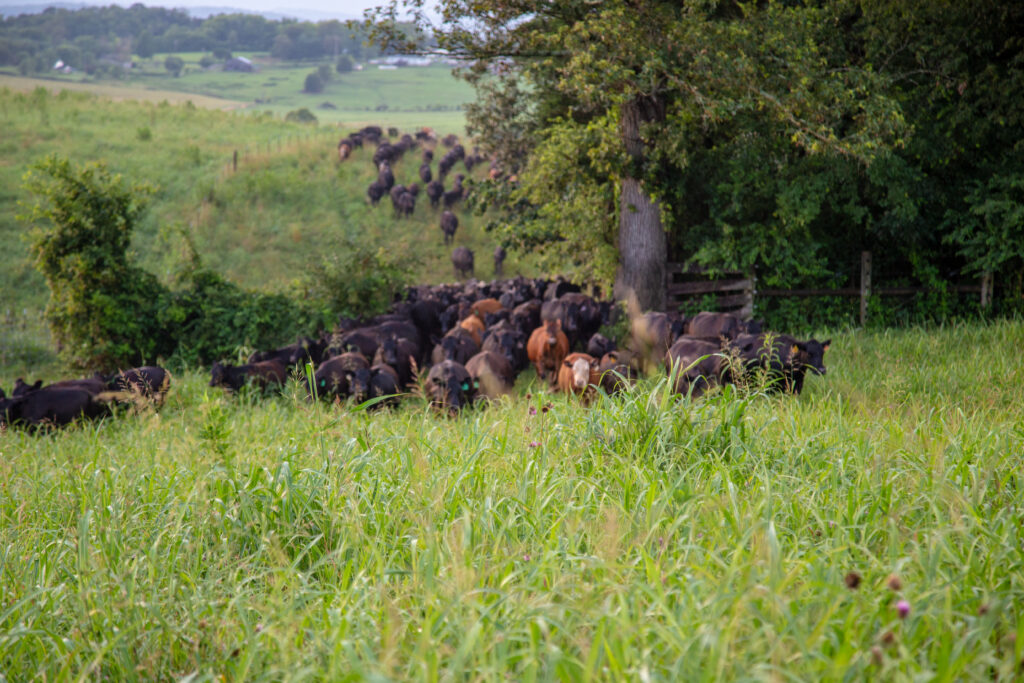
Measurements and Analysis
- Soil Analysis – Manual soil observations in field to contrast two zones of high-quality and low-quality soils.
- Browsing/Deterrence – After all grazings, browsing damage of each tree will be categorized as heavy, moderate, or no apparent damage.
- Grazing Behavior – During grazing, we will visually observe animals’ interaction with plantings and deterrents.
- Cost-Reduction - Materials and labor costs throughout the two-year project period will be documented and compared with precedent costs.
- Tree Mortality - Mortality by apparent cause will be tallied over time, and total mortality at 3 years will be compared with precedents.
Tree mortality and cost-reductions together will be analyzed to assess cost-effectiveness in terms of cost per surviving tree. Browsing deterrence will be compared between deterrent types. Basic statistical analysis will be used to determine the extent to which differences are statistically significant.
Results of Tree Establishment
- Due to wild bird consumption, Winter Rye was seeded twice. At this density, it had an allelopathic affect on trees. Exact seeding rate unknown due to amount lost to wild birds.
- Due to drought (and allelopathy), all tree species had difficulty establishing. Irrigation hose was installed along all plots, but only after the worst period of drought had passed. Apart from mulberry, no tree species were well-enough represented throughout all plots to measure accurately. Therefore, observations were made for the mulberry only. (Mulberry did not succumb to the drought, and is well-represented through all plots.)
- Because drought and cover crop allelopathy created such difficult growing conditions, in 2023, trees were watered several times, and fertilized once.
- Rye that was on lower quality soil grew less vigorously. Apparently due to this, overall tree growth on the poor soils was actually better than on the good soils, early in the trial. Later in the trial, good-soil plots had caught up.
Deterrent Establishment
- Due to drought during the first year of the project, deterrents had a difficult time establishing. The two herbaceous deterrent species (Wingstem and Mints) successfully established in all replications. The two woody species, however (Elderberry and Blackberry) established only erratically, and not consistently enough to provide accurate data between replications. Therefore, only the herbaceous deterrent species were observed.
Project Extension
- The project manager applied for and received a 12-month extension, to give more time for the trees and deterrent species to establish, before applying heavy timed grazing. However, informal observations were made during several grazing periods (described below).
Initial Results
- In the second and third years of the project, during informal grazing periods, the following was observed:
- Initial tubes (5' Tree Pro Slit tube) with bamboo stakes were heavily damaged by wind, and had to be removed. They were replaced with 6' Plantra Sunflex systems, which did not succumb to any wind damage.
- While the wind-dismantled Tree Pro tubes were pulled off and scattered by the cattle, no browsing damage occurred on the Plantra tubes.
- All other plots were grazed, though not heavily. A two-strand polywire fence was set between the trees and the cattle, with lower strand at approximately 22” and upper strand at approximately 34”, charged and running at over 7 kv (exceeded tester capacity).
- There was no apparent difference between the grazing that occurred on the plots with plant or brush deterrents, or the control. The only apparent difference was the lack of grazing on the trees in tubes (which cattle simply could not access).
- Both plant deterrents and brush deterrents were relatively small in size or low to the ground, whereas Mulberry forage was thick and robust and tall. The deterrents simply were not at the correct scale to protect the trees from grazing.
- In the last year of the project, the project manager had a child, delaying the application of heavy timed grazing at pre-specified densities.
- As of Spring 2025, both herbaceous deterrents are growing vigorously, whereas the woody deterrents have all but disappeared, and the cut brush deterrents have disintegrated. All Mulberries are growing vigorously and up to 8’ tall. Tubes are still in place and trees have come out the top. Growth in the Control plots, tubes, and all deterrent plots is more or less the same, with Mulberries on the “good” soils roughly 1’ taller on average than those in the poor soils.
Future Plans for the Project
- In May of 2025, we plan to measure, then coppice all of the Mulberry to 4” off the ground. This will result in strong regrowth of many stems, at a lower height. In June, we plan to replace the disintegrated woody deterrents with freshly cut brush. In July, August, and September, we plan to apply heavy timed grazing at the two prespecified densities of 10k and 100k lbs/acre. After each grazing, we will measure the height and characterize the condition of each of the six remaining active plots (we will exclude the 2 plots originally planted with woody plant deterrents that did not establish successfully). We will compare the establishment success and grazing deterrence effectiveness for all treatments. We will submit that as an addendum to our project in late 2025.
Initial Conclusions
- Winter rye can have a disastrous effect on young tree seedlings. Since other cover crops are also known to have allelopathic affects as well, we recommend care in using these with young trees. Careful control of seeding rates and use of diverse mixes that do not overly rely on any one species, is advisable. Also, one should be prepared to invest in methods of protection for seed during establishment. We used ample straw, but the swarming birds at that time of year just picked through it. A livestock guardian dog fenced into the area, scarecrow or other visual deterrent, or woven fabric to lay over the seed while it was germinating might have helped.
- Moving woody plant deterrent species that rely on taproots, like Elderberry and Blackberry, is not effective. Fibrous-rooted woody species may be more successful. In the case of using taprooted species, planting into an established stand -- if physically feasible -- may prove more effective (more closely mimicking the process observed in the UK precendent cited in our background literature).
- Mulberry is a very vigorous grower that does not seem to mind drought or poor soils or heavy pruning. Persimmon and pine, however, were very susceptible to drought and poor soils. Hybrid poplar did not respond well to the drought, but several trees did come back (“sucker back”) with new growth, whereas the pine and persimmon trees mostly died out-right.
- We recommend beginning silvopasturists in our region start with Red Mulberry to gain their skills and develop routines for managing fodder banks. (We prefer using Red Mulberry rather than the invasive White Mulberry, which threatens the native Red Mulberry(1).) For areas with ample rainfall, drought should not require irrigation to keep Mulberry alive, due to its quick ability to drop leaves and remain leafless without dying. Mulberry is also very easy to cut and plant as livestakes, increasing the density or breadth of the fodder bank.
- For developing Mulberry fodder banks, we recommend planting densely and mulching heavily, then using two strands of polywire with a moderate electric charge, and no tubes or deterrents other than the fence. This will likely need weedeating and/or mowing the perimeter multiple times a year for the first year or two, even with fairly dense grazing.
- If using Mulberry, and receiving ample rainfall, after two to three years, trees will have grown several feet tall and weedeating and mowing requirements should reduce or cease. We anticipate at this time that the fence can be removed and the fodder banks grazed openly, without permanently damaging the trees. We plan to try this in 2026 after the trees have regained some height, and will report our findings. Currently, our Mulberry stems range from 1” to 3.5” in diameter, and we do not believe at this size that they would be threatened by cattle at any density, so long as they had ample time (2-3 months) to recover, as well as a final ungrazed growing session before the end of the year.
- For developing “standard” trees, with single upright boles, we do not at this point recommend using any method other than a high-quality tube. The plots with high-quality tubes with sturdy stakes were completely untouched by the cattle. (However, it should be noted that elsewhere on the farm, we use the same tubes with energized polywire wrapping the tube. It is possible that had this not been the case, animals would have shown curiosity in the tubes and removed or dismantled the tubes.) One benefit of the tube in this case was that it is easy to work around with a string-trimmer, as the tube withstands minor string-trimming and allows you to cut back vegetation between and around the trees very quickly compared to unprotected trees, or trees with living deterrents that must be carefully (slowly) avoided.
- Our search continues for a sourced-on-site, plastic-free, no-waste deterrent. We will continue to monitor these plots and observe the effectiveness over time as the herbaceous plant deterrents mature and multiply. Of the methods we tried, we have the following impressions:
- Planting trees as 18”-3’ bareroot seedlings into an existing plot of herbaceous plant deterrents (a colony of wingstem, for instance) might result in better deterrence than planting the deterrent and the tree at the same time, because the deterrent would already be tall enough to shroud the tree. In this case, it would be important that only shade-tolerant tree species be used.
- Planting trees as livestakes or seeds/nuts into an existing plot of woody vegetation might be successful (if difficult); this was described as a practice used in the UK in the project proposal (and every unmowed part of our fields grows up first in shrubs and later in trees).
- One would be best off using cut brush as a deterrent in a scenario where
- There was already a very large amount of brush already going to be cut and disposed of;
- Brush pieces were arranged so that none that make good “back scratches” were available to the grazers;
- Planted tree species were relatively fast-growing; and
- Planted trees could be planted as seeds or livestakes AND/OR brush contained no thorns.
- We found that the thorns were problematic to us as humans, but not so much so to the cattle. We think the general “unappealing look” of a brush pile to a bovine is the main reason they would avoid it. We also found it is important to be able to get into the pile, plant the tree rapidly, then extricate oneself – a process which works much more easily with livestakes and non-thorny species. Otherwise the planting is practically unfeasible.
(1) https://extension.umd.edu/resource/invasives-your-woodland-white-mulberry/
Educational & Outreach Activities
Participation Summary:
09/07/2022 Webinar: “Trees for Shade, Fodder, and Carbon Revenue.” Virtual presentation targeting national producers and researchers. Hosted by Working Trees, LLC and in Cooperation with Virginia Tech. 210 live attendees plus 218 youtube viewers as of 5/11.25. https://www.workingtrees.com/blog/working-trees-webinar
04/06/2023 Webinar: Appalachian Sustainable Development's Ask an Agroforester Series Presentation “Advanced Tree Protection in Livestock Operations.” Virtual presentation targeting southeastern producers and agricultural professionals. Hosted by Appalachian Sustainable Development. Archived Youtube version has 951 views as of 5/11/25. https://www.youtube.com/watch?v=KxJN-YUjJOk
10/24/23 On-farm Demonstration: Plantra, Inc. Professional Development Activity, for Plantra R&D staff and manufacturing employees. Hosted by Plantra, Inc. 20 Attendees.
12/8/23 Webinar: Savannah Institute's Perennial Gathering Presentation "Fencing, Tree Tubes, and Innovation." Virtual presentation targeting national producers and technical assistance providers. Hosted by Savannah Institute. Archived Youtube version has 349 views as of 5/11/25. https://www.youtube.com/watch?v=28bO-gdiHbA
1/17/24 Webinar: University of Missouri's Center for Agroforestry's Annual Symposium's "Silvopasture Across Regions and Climates." Virtual presentation targeting national producers and technical assistance providers. Hosted by Center for Agroforestry. Archived Youtube version here has 298 views as of 5/11/25. Condensed archived Youtube version here has 179 views as of 5/11/25. Total 477 views.
2/13/2024 Webinar: Woodland Stewards Series' "Establishing Hardwood Silvopasture Systems When Starting From Pastures or Woodlands (2024 WS Series 3/6)." Hosted by Southern Regional Extension Forestry. Available on-demand through forestrywebinars.net. Archived video has 89 views as of 5/11/25.
3/5/2024 Webinar: Woodland Stewards Series' "Silvopasture producers share their stories and Answer Questions: A Panel Discussion (2024 WS Series 6/6)." Hosted by Southern Regional Extension Forestry. Available on-demand through forestrywebinars.net. Archived video has 23 views as of 5/11/25.
5/3/2024 Farm Tour: Lick Skillet Silvopasture Farm Tour and Networking Breakout Sessions. All-day event including morning refreshments and lunch. Hosted by Lick Skillet Farm. Audience was local producers and natural resource professionals. 42 Attendees.
3/1/2025 Workshop/Field Day: Bluebird Hill Farm's Community Agroforestry Workday. Hosted by Strong Roots Resources. Audience was local producers. 15 Attendees.
Total participants as of 5/11/25 = 2,394.
.
Learning Outcomes
Awareness of agroforestry practices, especially silvopasture
Technical knowledge of how to establish (plant, protect, maintain) trees in cattle pasture
Acceptance of the idea of intentionally placing/cultivating trees in pasture
Skills of how to conceive and design a silvopasture project
Knowledge of some of both conventional and unconventional methods of establishing silvopasture trees
Knowledge of how silvopasture can complement a larger grazing management plan
Awareness of some grant opportunities available for new silvopasture and other agroforestry projects
Awareness of agency staff who are able to provide technical assistance
Project Outcomes
This project identified some of the pitfalls associated with sustainable methods of tree establishment, and indicated the most fail-proof method of tree protection for beginning silvopasturists. It indicated some of the major factors that drive up cost and impact tree survival. For cattle farmers in the Mid-south, this project indicated two clear directions forward for establishing either fodder banks or shade trees. It also helped provide a unique example of silvopasture that natural resource professionals can observe and learn from.
For future study, we recommend
- developing standard (regional) cover crop mixes for tree establishment,
- developing standard (regional) methods for cultivating Red Mulberry fodder banks,
- collecting nutritional analyses of various woody browse/fodder species, throughout the seasons,
- developing standard guidance for how woody fodder banks can complement a grazing management system and address annual nutritional gaps, and
- continuing the search for a reliable and effective low-waste tree protection method.